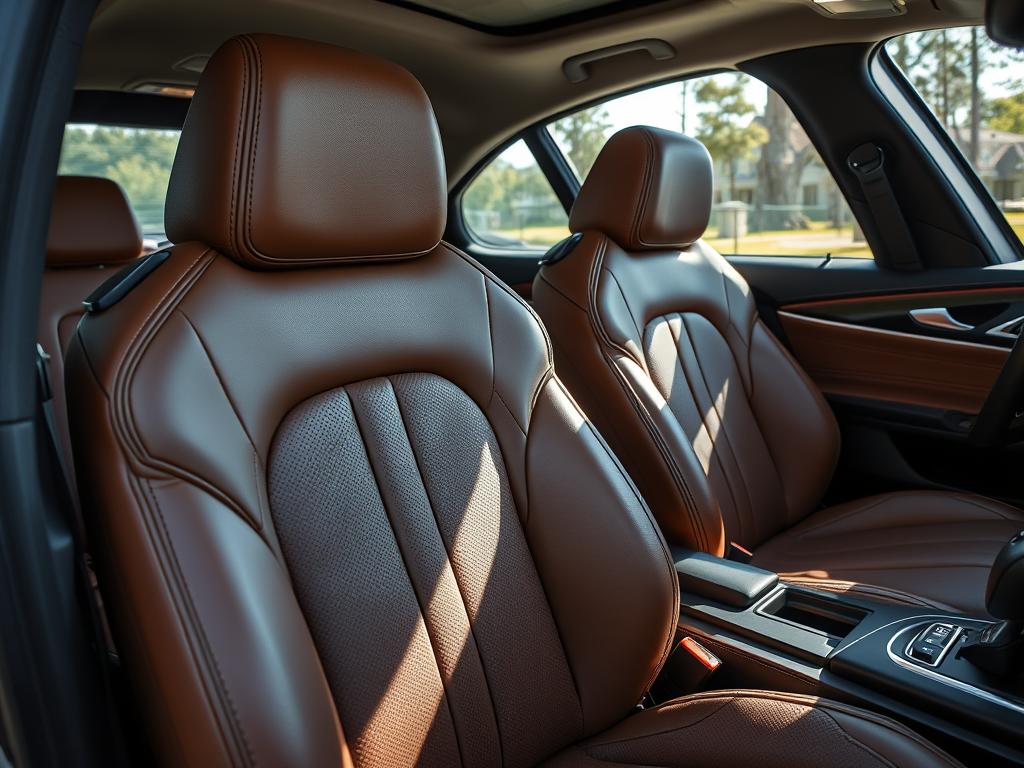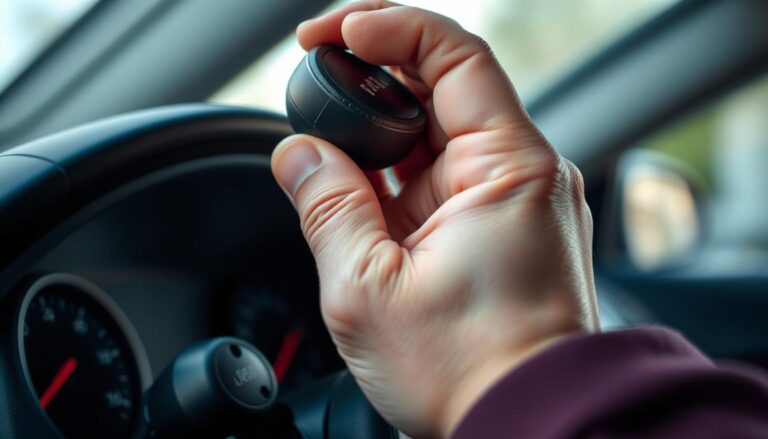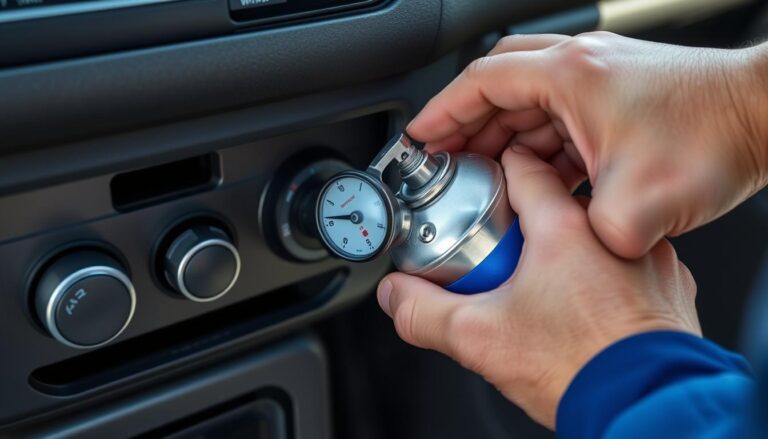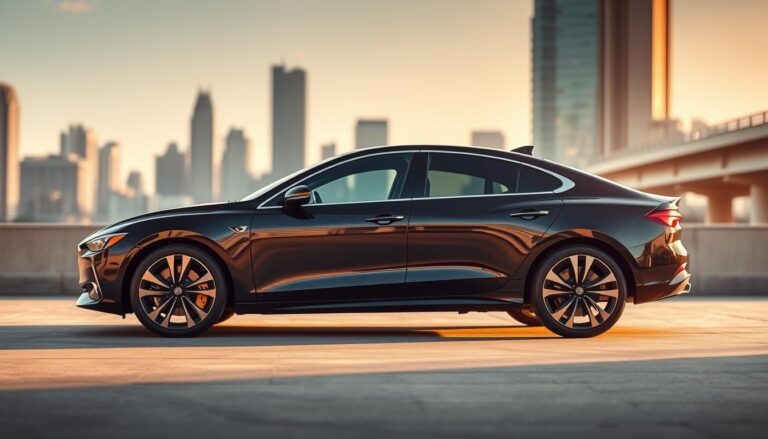When choosing a BMW, the interior upholstery significantly impacts both your driving experience and the vehicle’s long-term value. BMW offers two primary options: Sensatec synthetic leather and genuine leather. Each material has distinct advantages and considerations that align with different priorities and lifestyles.
This comprehensive comparison will help you understand the key differences between BMW Sensatec and genuine leather, examining factors like durability, comfort, maintenance requirements, and cost implications. By the end, you’ll have all the information needed to select the perfect upholstery for your BMW interior.
What Is BMW Sensatec?
Sensatec is BMW’s proprietary synthetic leather material designed to mimic the look and feel of genuine leather while offering practical advantages. It’s made from a polyurethane or vinyl base with a specialized coating that creates a leather-like texture and appearance.
As BMW’s standard upholstery option in many models including the X1, X3, 3-Series, and 5-Series, Sensatec provides a premium feel without the additional cost of genuine leather. The material is engineered to be durable, stain-resistant, and low-maintenance.
Key Features of Sensatec
- Synthetic composition with no animal products
- Uniform texture and consistent appearance
- Available in various colors including black, beige, brown, and red
- Standard option in many BMW models
- Engineered for durability and easy maintenance
What Is BMW Genuine Leather?

Genuine leather upholstery in a premium BMW model
BMW offers several grades of genuine leather upholstery, with Vernasca and Merino being the most common options. These materials are made from real cowhide that undergoes specialized tanning and treatment processes to enhance durability while maintaining the natural characteristics of leather.
Genuine leather is typically offered as an upgrade option across the BMW lineup, adding approximately $1,500-$2,500 to the vehicle price depending on the model and leather grade. The premium price reflects both the material quality and the craftsmanship involved in its installation.
BMW Leather Options
- Vernasca Leather: Entry-level genuine leather with a corrected grain
- Dakota Leather: Mid-range option with a softer feel (available on some models)
- Merino Leather: Premium grade with finer grain and exceptional softness
- Individual Leather: Exclusive customized leather options for select models
Durability and Longevity Comparison
Sensatec Durability

Sensatec offers excellent resistance to wear and tear due to its synthetic composition. It’s less prone to scratching than genuine leather and holds up well against spills, stains, and UV exposure. Many BMW owners report that Sensatec maintains its appearance with minimal care even after years of use.
The material doesn’t develop the natural patina that leather does over time, which means it generally looks the same throughout its lifespan. This consistency can be an advantage for those who prefer a uniform appearance.
Leather Durability

Genuine leather, when properly maintained, can last the lifetime of the vehicle. However, it requires more care to prevent cracking, fading, and wear. Quality leather like BMW’s Vernasca and Merino grades are treated to enhance durability, but they remain more susceptible to damage from sharp objects and spills.
One distinctive characteristic of real leather is that it develops a patina over time, often becoming more supple and developing character with age. Many luxury car enthusiasts appreciate this natural aging process as it adds to the premium feel.
Comfort and Feel Comparison
Sensatec Comfort

Sensatec provides a firm, supportive feel that many drivers appreciate. However, it doesn’t breathe as well as genuine leather, which can make it feel warmer in hot weather and cooler in cold weather. The material can sometimes feel slightly stiffer than real leather, especially when new.
BMW has continuously improved Sensatec’s comfort properties over the years. Newer versions like SensaTec 2.0 and Veganza offer enhanced breathability and a softer touch that more closely mimics genuine leather.
Leather Comfort

Genuine leather offers superior breathability, which helps regulate temperature by allowing air circulation. It naturally adapts to body temperature, feeling cooler in summer and warmer in winter compared to synthetic materials.
Another advantage of leather is that it becomes more supple and conforms to your body over time, potentially offering a more personalized comfort experience. The natural properties of leather create a distinctive tactile experience that many luxury car owners prefer.
Temperature Regulation
If you live in an area with extreme temperatures, leather’s superior breathability may provide more comfort throughout the seasons. However, both materials work well with BMW’s heated and ventilated seat options.
Maintenance Requirements
Sensatec Maintenance

One of Sensatec’s biggest advantages is its low maintenance requirements. The material can typically be cleaned with just a damp cloth and mild soap. It doesn’t require conditioning or specialized products to maintain its appearance.
Sensatec is highly resistant to stains and spills, making it an excellent choice for families with children or those who frequently eat and drink in their vehicles. Most liquid spills can be wiped away without leaving permanent marks.
Leather Maintenance

Genuine leather requires regular maintenance to preserve its appearance and prevent deterioration. This typically includes cleaning with leather-specific products and applying conditioner every few months to prevent drying and cracking.
Leather is more susceptible to damage from UV exposure, so vehicles with leather interiors benefit from window tinting or regular use of UV protectant products. Spills should be cleaned promptly to prevent staining or discoloration.
Keep Your Leather Looking New
For BMW owners with leather interiors, proper maintenance is essential. Quality leather care products can extend the life and preserve the appearance of your leather upholstery.
Cost Implications
| Factor | Sensatec | Genuine Leather |
| Initial Cost | Standard option (included) | $1,500-$2,500 upgrade |
| Maintenance Cost | Low (basic cleaning supplies) | Moderate (specialized products) |
| Resale Value Impact | Neutral to slightly negative | Positive (adds value) |
| Long-term Value | Good (durable with minimal investment) | Excellent (with proper maintenance) |
The cost difference between Sensatec and leather extends beyond the initial purchase price. While leather requires a higher upfront investment and ongoing maintenance costs, it typically contributes positively to a vehicle’s resale value. Sensatec offers excellent value for those prioritizing practicality and lower total cost of ownership.
Resale Value Consideration
For luxury vehicles like BMW, genuine leather interiors can increase resale value by 5-10% compared to synthetic options. This may partially offset the higher initial cost for owners who plan to sell within 3-5 years.
Aesthetic Appeal
Sensatec Aesthetics

Sensatec offers a clean, uniform appearance with consistent coloration and texture throughout the interior. BMW has refined this material to closely resemble genuine leather, making it difficult for casual observers to distinguish between the two.
Available in various colors including black, beige, brown, and red, Sensatec provides ample customization options. The material maintains its appearance well over time without developing the patina or character marks that leather acquires.
Leather Aesthetics

Genuine leather provides a premium look with natural grain variations that add depth and character to the interior. The material has a distinctive sheen and texture that many associate with luxury vehicles.
BMW’s leather options come in an extensive range of colors and finishes, from classic black and tan to bold reds and blues. Higher-grade options like Merino leather feature finer grain patterns and more sophisticated color treatments.
“The difference between Sensatec and leather is most noticeable in person. While photos may look similar, the tactile experience and subtle visual details of genuine leather create a more premium impression.”
Environmental Impact

Environmental considerations for different upholstery materials
Sensatec Environmental Factors
As a synthetic material, Sensatec is animal-free, making it appealing to those with ethical concerns about using animal products. However, its production involves petroleum-based materials and chemical processes that have their own environmental implications.
BMW has been working to improve the sustainability of its synthetic materials. Newer versions like Veganza incorporate recycled materials and more eco-friendly production methods, reducing the overall environmental footprint.
Leather Environmental Factors
Genuine leather production involves animal agriculture and tanning processes that can have significant environmental impacts, including water usage, chemical treatments, and carbon emissions. However, as a byproduct of the meat industry, some argue that leather utilizes materials that would otherwise be wasted.
BMW sources its leather from suppliers that adhere to environmental and ethical standards, and the company continues to improve the sustainability of its leather processing methods.
BMW Sensatec vs Leather: Comprehensive Comparison
| Feature | BMW Sensatec | BMW Genuine Leather |
| Material Composition | Synthetic (polyurethane/vinyl) | Natural cowhide |
| Initial Cost | Included as standard | $1,500-$2,500 upgrade |
| Durability | Excellent resistance to wear, stains | Good with proper maintenance |
| Comfort | Good, less breathable | Excellent, breathable, adapts to body |
| Maintenance | Low (simple cleaning) | Moderate (regular conditioning) |
| Appearance | Uniform, consistent | Natural grain, develops patina |
| Temperature Regulation | Fair | Excellent |
| Environmental Impact | Animal-free, petroleum-based | Animal product, resource-intensive |
| Resale Value Impact | Neutral | Positive |
Recommendations Based on Use Cases
Choose Sensatec If You:
- Prioritize low maintenance and durability
- Have children or pets that may damage upholstery
- Want to minimize initial vehicle cost
- Prefer animal-free products
- Live in extreme climates where leather may crack
- Plan to keep your vehicle for many years
Choose Leather If You:
- Value premium feel and luxury appearance
- Are willing to perform regular maintenance
- Want better temperature regulation and breathability
- Consider resale value a priority
- Appreciate materials that improve with age
- Plan to sell your vehicle within 3-5 years
Climate Considerations
Hot Climates
In hot, sunny regions, leather can become extremely hot when exposed to direct sunlight. However, its breathability helps it cool down quickly once the air conditioning is running. Sensatec may stay cooler initially but retains heat longer.
Recommendation: If choosing leather in hot climates, consider lighter colors and window tinting. Ventilated seats are beneficial with either material.
Cold Climates
In cold regions, leather can feel cold to the touch initially, while Sensatec typically feels less cold. Both materials work well with heated seats, which are common in BMW models.
Recommendation: Either material works well in cold climates when paired with heated seats. Leather may require additional conditioning to prevent drying in low-humidity winter environments.
Conclusion: Making Your Decision
The choice between BMW Sensatec and genuine leather ultimately depends on your personal priorities, lifestyle, and how you plan to use your vehicle. Both materials offer distinct advantages that appeal to different types of owners.
Sensatec provides excellent value, durability, and low maintenance requirements, making it ideal for practical-minded owners who want a premium look without the additional care requirements. Genuine leather offers superior comfort, a truly luxurious feel, and potential resale value benefits for those willing to invest in both the initial cost and ongoing maintenance.
Consider your daily driving habits, local climate, budget constraints, and how long you plan to keep your BMW when making this important decision. Whichever option you choose, BMW’s commitment to quality ensures that both Sensatec and leather will provide an enjoyable driving experience for years to come.
Experience BMW Upholstery Options In Person
The best way to decide between Sensatec and leather is to experience both materials firsthand. Visit your local BMW dealership to see and feel the difference for yourself.
Frequently Asked Questions
Is BMW Sensatec real leather?
No, BMW Sensatec is not real leather. It’s a synthetic leather alternative made from polyurethane or vinyl materials designed to mimic the look and feel of genuine leather while offering practical benefits like increased durability and lower maintenance requirements.
How long does BMW Sensatec last?
With proper care, BMW Sensatec can last the lifetime of the vehicle. Its synthetic composition makes it highly resistant to wear, fading, and cracking. Many BMW owners report Sensatec maintaining its appearance well beyond 10 years of regular use.
Is BMW leather worth the upgrade?
For many luxury car enthusiasts, BMW leather is worth the upgrade for its superior comfort, breathability, and premium feel. It also typically enhances resale value. However, the value proposition depends on your priorities—if low maintenance and durability are more important than the luxury experience, Sensatec may be the better choice.
Can you get Sensatec in all BMW models?
Sensatec is available as the standard upholstery option in most BMW models, including the X1, X2, X3, X4, 2-Series, 3-Series, 4-Series, 5-Series, i4, iX, and Z4. However, availability may vary by model year and market region. Some high-end models like the 7-Series may offer different standard materials.


